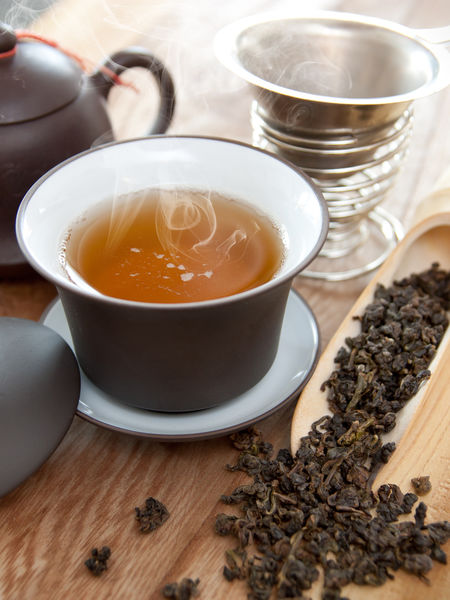Gra-tea-tude


There Might Be An "I' In “Gratitude,” But There's Also A "U" And A "Tea."
I’ve written before on how to take a concept and turn it into a tea.
The Signature Blends Series on Teamuse, for example. You’re conceiving of a particular character — or in some cases, the abstract, intangible components that make up their personality — and suddenly it’s your job to make a drinkable foodstuff out of it. This requires synesthetic gymnastics that would put you in the same class as Simone Byles. (And if she doesn’t have a tea already, someone get out there and make one.*)
Now, my current challenge is how to harness that seemingly irrelevant power, in order to create a tea that embodies a concept that we can all focus on this year: Gratitude.
And it’s hard. Both the conceiving of gratitude, and the manifestation of it.
Holidays are usually a time when we all come together and stuff ourselves amongst family, while thinking about what Netflix movie we’ll be watching afterwards. (Do they have any tea documentaries yet? Someone needs to get on that, too.)
We could, of course, take the easy way out. It’s guilt-inspiringly simple to Youtube up a Deepak Chopra playlist, and get into a deep meditation session that may or may not pull up some traumatic childhood holiday memories before it becomes apparent what gratitude really means to us, on an individual level.
But if long, involved meditation isn’t your thing, then any experienced meditator will let you know that it’s ok. There are many ways to cut this turkey. (Or Tofurky, dear vegans. Or cheese, dear vegetarians. Did we cover all our dietary possibilities? Ok, excellent.)
For a simpler form of meditation, perhaps more accessible to the novice, try the feeling of looking inside yourself as a single person, outside the context of others. Let this inform how you take ownership of the way you experience gratitude. Indulge your sense of subjectivity.
Identify the very specific things that you are grateful for. Find something tangible about them. Then breathe. If you’ve committed to it with proper intention, you might experience shapes, sounds, smells, tastes, and colors, all of which remind you of what makes you grateful for the fortunes you have received in your existence.
Woo, headrush! Jot down the sensations before you lose them. These are the ingredients for your Gratitude tea.
Here’s an example of my own gratitude blend:
The Giving Tea
Ti Kuan Yin Lemongrass Ginger Dragonfruit
Combine these in a 3:2:1 ratio. Meaning, for example, 3 dry cups of Ti Kuan Yin (roughly 12 ounces), then you would add to it 2 dry cups of Lemongrass Ginger (or 8 ounces, approximately) and then 1 cup of the Freeze Dried Dragonfruit.
Since the base tea is an oolong, you would therefore treat the blend as such whenever you want to steep a cup: boiling water, 2-3 minutes at a time. And with the light flavor of the dragonfruit, and the hardiness of the lemongrass and ginger, you could re-steep this beauty all through the night with your loved ones.
So why these ingredients?
Whenever I’m grateful for what life has brought me, I think of Ti Kuan Yin. Not just for the spiritual significance of the tea — Kuan Yin is indeed the Goddess of Compassion and/or Mercy, depending on where you’re getting your translation — but because of the memories which it holds in every sip.
It was one of my first true teas to review when I started a baby tea blog in 2013, sent to me by a friend. Then later, when I branched away from tea and into fitness, it became the centerpiece for a Mother’s Day tea and yoga workshop, dedicated to finding the strength for self-compassion and self-care while learning more about yourself through the legend of Kuan Yin herself.
The Lemongrass Ginger is for my health. Forgive me again, but I’m taking the time to be grateful for not being sick or injured right now. In this industry, it’s never taken for granted, so you can bet your bancha that we have to celebrate it every chance we get.
(And the cornflowers in there are for Earl Grey, which will always and forever be a tender nod to Picard. Can’t forget fandom, dear friends.)
Now we get to the Freeze-Dried Dragonfruit. I’m more than a little excited about the way Adagio has grown, and this is symbolic of it. Taking risks, trying new things that no one has ever done in the world of tea. And you know what? I’m thankful for it. They’ve brought me many steps of the way to where I am now.So thank you, Adagio.
Thank you, Kuan Yin.
And thank you, Captain Jean-Luc Picard, as we continue to soldier on in 2019, going where no one has gone before.
Cheers!
*Preferably with turmeric, in honor of soothing herbs for athletic joints, and maybe some hibiscus, plus you gotta throw in a dash of cinnamon to spice up the routine — goodness, I’ve gone off again. Old tea somme habits.
But at least it’s illustrating my point. Conceptual flavor-making to embody a fantastic figure. Go Wild(-e) with it.
